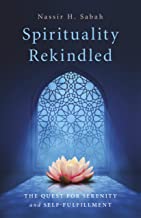by Nassir H. Sabah
In addition to some miraculous verses, the Quran has a miraculous set of intricate numerical relations that cannot possibly be all accidental or of human origin and which objectively attest its Divine origin.
The Quran has an intricate web of numerical relations involving letters, verses, and chapters of the Quran. To place these relations in their proper perspective it is necessary to give some background information on the Quran.
The Quran is the Holy Book of Islam, the most recent of the three Abrahamic religions – the other two being Judaism and Christianity. Muslims believe that the Quran was revealed to the Prophet Muhammad through the angel Gabriel at intervals over a period of 23 years, starting in 609 CE when The Prophet was 40 years old and culminating in 632 CE, the year of his death. The Quran was revealed in Arabic, a rich, root-based, structured language having an elaborate syntax and word derivation. It is widely believed, though disputed by some, that the Prophet Muhammad could not himself read or write, lest he be accused of writing the Quran with his own hands. The Quran attests to Jesus being a Messenger of Allāh – which is the proper name in Arabic of the One and Only Divine Being¸ The Almighty who created the universe and is the Sustainer and Guide of everything in it. According to the Quran, Jesus was blessed with performing miracles, such as raising the dead and healing the blind and the leper ((3:49) and (5:110)).1 The Virgin Mary is highly venerated as the only woman mentioned by name in the Quran and who was purified by The Almighty and chosen above all women (3:42).
The Quran has a very well documented authenticity. According to Stanley Lane-Poole, the 19th century CE British Orientalist: “It is an immense merit in the Ḳur-án that there is no doubt as to its genuineness. The ‘Word of the Lord’ came to Moḥammad, and he uttered it, and the people wrote it down or committed it to memory; and that very word we can now read with full confidence that it has remained unchanged through nearly thirteen hundred years.”2 Because of the peculiarities of the Arabic language, Quranic verses can have multiple meanings. Hence, the only Quranic text that is officially recognized by Islamic authorities all over the world is the original Arabic text. No translation of the Quran to any language is recognized as official because a translation only reflects the meaning of verses as understood by the translator. It is important to keep in mind for our purposes that: (i) the division of the Quran into chapters, and the arrangement of Quranic verses within these chapters, are not chronological, but were directed by the Prophet Muhammad himself under Divine guidance, and (ii) for non-Muslims, the Quran is to be regarded as a stand-alone text that should be appraised on its own merits without prejudice or bias.
The Prophet Muhammad himself did not perform any miracles, unlike other prophets mentioned in the Quran, including Moses and Jesus, for example. In fact, when his infant son died there was a solar eclipse. Some of the Prophet’s followers considered this a miraculous sign. Instead of confirming such a belief, which would have bolstered his prophethood, the Prophet admonished: “The Sun and the Moon do not eclipse because of the death or birth of someone but are two signs amongst the Signs of Allāh.”
As it turns out, the Quran is itself miraculous in several ways that attest its Divine origin. Apart from its linguistic and literary inimitability the Quran has many miraculous verses, some of which are science-based.3 What concerns us here is another remarkable miraculousness that was destined to be revealed only in modern times when the Quranic text was digitized, and it became practical to do extensive counting of Arabic words and letters. An Egyptian-American biochemist, Dr. Rashad Khalifa, presented in the mid-1970s a theory about the Quran’s miraculousness which he claimed was based on numerical relations involving the number 19. Although some of his counts were correct, it was soon discovered that not only were many of his results incorrect, but that he even falsified some results to support his claims. He got so carried away with his theory that he proclaimed himself a messenger of The Almighty.
Nevertheless, he did in fact set in motion the quest for investigating numerical relations in the Quran using increasingly sophisticated search tools. The result has been the continual discovery of an astounding intricate web of numerical relations in the Quranic text. It is as if these relations were intended as a recurring miracle – a miracle that keeps on giving, unlike a one-off miracle. Moreover, these numerical relations are completely objective and clear-cut; they do not depend on any linguistic, philosophical, or theological interpretations of verses, just simple arithmetic and consistent rules of counting Arabic letters and words.4
A few examples are given in what follows to illustrate what is involved.
- Consider some multiples of the number 7, a number that has mystical symbolism in practically all ancient cultures and religions since at least Babylonian times.4 The Quran has 114 chapters and 6236 numbered verses. If these are laid side by side, with the smaller unit (verse) on the right and the larger unit (chapter) on the left, bearing in mind that Arabic is written and read from right to left, the resulting number 1146236 is a multiple of 7. If the order of the numerals is reversed, the number 6326411 is also a multiple of 7. If the individual numerals in the numbers 114 and 6236 are added, the sum is 23, the number of years over which the Quran was revealed. If this number is laid side by side with the number 23 replacing the number of chapters, the result 236236 is a multiple of 7. If the order of the numerals is reversed, the number 632632 is also a multiple of 7. If the number 23 is laid side by side with the number of chapters replacing the number of verses, the resulting number 23114 is a multiple of 7. If the order of the numerals is reversed, the number 41132 is also a multiple of 7. The number of digits of the first number formed (1146236) is 7, the number of digits of the second number formed (236236) is 6, and the number of digits of the third number formed (23114) is 5. If these are written in the order of the number of digits of the first number on the right, the resulting number 567 is a multiple of 7. If the number of the first chapter, (1), is written to the right of the number of the last chapter, (114), the resulting number 1141 is a multiple of 7. The 4 numerals of 1141 also add to 7. All coincidences?
- Chapter 55 (The Most Compassionate) contains a refrain verse – “So which of your Rabb’s favors do you deny?” – that is repeated 31 times, mostly after one other verse and in four instances after two other verses. What about the number 31? If the numbers 1 to 31 are laid side by side, with the first number 1 on the right and ending with number 31 on the left, the result is a 53-digit number: 31302928272625242322212019181716151413121110987654321, where the odd numbers are in bold for clarity. This number is a multiple of 7, as can be readily verified.5 If the order of the numerals is reversed, the resulting 53-digit number is: 123…90111…920313, where odd numbers, reversed when more than 9, are in bold for clarity. This number is also a multiple of 7, as can be readily verified.6 The first refrain verse is number 13 in Chapter 55 and the last refrain verse is number 77. If the verse numbers of the 31 refrain verses are laid side by side, starting with number 13 on the right and ending with number 77 on the left, the result is a 62-digit number: 77757371696765636159575553514947454240383634323028252321181613, where alternate verse numbers are in bold for clarity. This number is a multiple of 7, as can be readily verified.7 If the order of the numerals is reversed, the resulting 62-digit number is: 316181…375777, where the same verse numbers, in reverse, are in bold for clarity. This number is also a multiple of 7, as can be readily verified.8 All coincidences?
- The reference in the Quran to the development of the human embryo is in verse 13 and the first part of verse 14, Chapter 23 (The Believers). In Arabic, this passage consists of 23 words and uses 23 letters of the Arabic alphabet of 28 letters. Humans have 23 pairs of chromosomes. Coincidence? Then consider the mention of bees in the Quran, which occurs only in verse 68, Chapter 16 (The Bees). In Arabic, the verse consists of 16 words and uses 16 letters of the Arabic alphabet. The first part of the verse up to and including the word bees consists of a total of 16 letters. The number of verses in Chapter 16 is 128, a multiple of 16, and the number of words is 2080, a multiple of 16. The number of words from the beginning of the chapter until the word bees is encountered is 992, a multiple of 16, and the number of words including the word bees and till the end of the chapter is 1088, a multiple of 16 (68×16), where 68 is the verse number where bees are mentioned. Female bees (workers) have 16 pairs of chromosomes, whereas male bees (drones) have 16 unpaired chromosomes. All coincidences?
- The number 19 also has mystical significance. It consists of the first (nonzero) and the last numerals of the decimal system and is considered to be a reference to The First and The Last, these being two of The Most Exalted Names of The Almighty in the Quran. This is similar to the Biblical passage: “I am the Alpha and the Omega, the first and the last, the beginning and the end.” (Revelation 22:13), where alpha and omega are the first and last letters, respectively, of the classical Greek alphabet. The number 19 is believed to be the first number revealed to the Prophet Muhammad (verse (74:30)). Verse 31 that follows is interpreted to mean that the number 19, in numerical miraculous relations, would convince the People of the Book (that is, Jews and Christians) that the Quran is of Divine origin. For this purpose, and in additional veneration of the Virgin Mary, Chapter 19 of the Quran bears her name. This chapter has 1083 words, not counting the disjointed letters at the beginning of the chapter and following well-defined rules of counting Arabic words and letters.4 This number is: 1083 = 19×19×3. The first 19 could be a reference to the chapter number, whereas the second 19 could be a reminder of the significance of the number 19 as indicated in the aforementioned verses 30 and 31 of Chapter 74. What about the number 3? It is the number of times the name Mary (Maryam in the Quran) is repeated in Chapter 19. The first mention of the name Mary is in verse (19:16) and the third mention is in verse (19:34). Verses 16 to 34 narrate the events from the conception of Jesus (Issa in the Quran) till his birth. The number of these verses is 19. The name Issa occurs only once in this chapter, in verse (19:34). The number of words from the first word in Chapter 19 until the name Issa is reached is 361 = 19×19, and the number of words beginning with the name Issa and till the end of the chapter is 722 = 2×19×19. The name Issa occurs in the Quran 25 times and its occurrence in Chapter 19 is the 19th occurrence. All coincidences?
- 29 chapters of the Quran begin with special letters (the so-called disjoined letters) which consist of a single letter or a group of 2 to 5 letters whose significance or meaning remains enigmatic to this day. Nevertheless:
- They form a set of 14 different phrases, without repetition, and they use 14 Arabic letters. The number 14 is a multiple of 7 and the sum of the two fourteens is 28, the number of letters of the Arabic alphabet. 28 added to 29, the number of chapters having disjoined letters, is 57, which is a multiple of 19. The number of chapters in the Quran is 114, also a multiple of 19.
- The Arabic letter qāf (equivalent to the English letter “q”) is the first letter of the Arabic word “Quran”. It is the special letter at the beginning of Chapter 50 (Qāf) and is also part of the two sets of special letters at the beginning of Chapter 42 (The Counsel). These are the only two occurrences of qāf in the special letters. Now qāf occurs 57 times in Chapter 50 and 57 times in Chapter 42 when the two qāfs in the special letters are included. 57 is a multiple of 19, and the sum of the two 57s is 114, the number of chapters of the Quran. In other words, the special letter qāf at the beginning of the chapter makes the total number of qāf in the chapter a multiple of 19.
- One of the special letter combinations is the two-letter yā sīn at the beginning of Chapter 36 (Yā Sīn), which is considered “The Heart of the Quran”. In this Chapter, yā (equivalent to English i or y) is repeated 237 times and sīn (equivalent to English s) is repeated 48 times, including the occurrences in the special letters. The two letters are repeated a total of 285 times, a multiple of 19. The order of this chapter in the sequence of Quranic chapters that begin with special letters is also 19. All coincidences?
Many more instances of these special numerical relations can be found in references 3, 9, 10 and more relations continue to be discovered. If one picks a book at random it is entirely possible that a number of numerical relations can be found that occur by accident and not by design. The types of special numerical relations that are found in the Quran are varied, based on: numbers of letters in words or verses; numbers of words in verses or chapters; numbers obtained by addition, or by positioning as decimal digits; or numbers of letter combinations in some words; or numerical relations that are context related. The resulting numbers have special significance or are multiples of numbers of mystical significance such as 7 or 19. If each individual numerical relation has a probability between 0 and 1 of occurring by chance, the probability of all the very large number of these relations occurring by chance is of the order of the product of the individual probabilities and is vanishingly small.
It is possible nowadays, at least in principle, and using supercomputers and appropriate algorithms and programs, to design a meaningful text of the size of the Quran – of about 77,000 words – having any number of desired special numerical relations. But was that possible in the 7th century CE? And produce a book having all the other miraculous features of the Quran? So how can the Quran be of other than Divine origin?
This article is adapted from the author’s most recent book, Number 3 in the Notes and References. He could be reached through his website nassirsabah.com.
Notes and References
- In references to Quranic text, the first number, before the colon, is the number of the chapter, whereas the second number is that of the verse in the given chapter. For a good English translation and commentary on the Quran, see: Nasr, S. H. (editor-in-chief) (2015) The Study Quran: A new Translation and Commentary, New York, HarperOne.
- Lane-Poole, S. (1879) ‘Introduction’, in E. W. Lane, Selections from the Ḳur-án, Ludgate Hill London, Trübner & Co., p. c.
- Sabah, N. H. (2023) Spirituality Rekindled: The Quest for Serenity and Self-Fulfillment, London and Washington, O-Books, John Hunt Publishing (In Press).
- Al-Kaheel, A. D., The Marvels of the Number Seven in the Noble Qur’an, (trans. M.R. Al-Salah) [Online]. Available at http://kaheel7.com/book/marvels_bookseven.pdf.
- The given number is: 7×4,471,846,896,089,320,331,744,574,168,816,593,059,017,301,569,664,903.
- The given number is: 7×1,763,668,414,444,590,202,165,959,741,574,460,332,036,089,611,845,759.
- The given number is: 7×11,108,195,956,680,805,165,653,650,502,135,350,605,769,090,617,575,464,617,311,659.
- The given number is: 7×4,516,873,189,326,004,620,519,757,749,353,563,076,508,227,880,522,395,659,625,111.
- Al-Kaheel, A. D., Kaheel Encyclopedia for Quran Miracles/Numeric Miracle [Online]. Available at https://kaheel7.net/?cat=43&lang=en.
- Jarrar, B. ‘Numeric Miracles of the Holy Qur’an – Chosen Examples’, Noon Center for Qur’anic Studies & Research [Online]. Available at http://www.islamnoon.com/language/chosen%20examples.pdf.
MEET THE AUTHOR
NASSIR H. SABAH is a neuroscientist/biophysicist and Professor of Electrical and Computer Engineering at the American University of Beirut, Lebanon. He has over 100 technical publications, mainly in neuroscience, biophysics, and biomedical instrumentation and has authored four books on electric circuits, electronics, and neuroscience.
On the web
nassirsabah.com
Bookshelf
SPIRITUALITY REKINDLED: THE QUEST FOR SERENITY AND SELF-FULFILLMENT BY NASSIR H. SABAH, published by O Books, eBook and Paperback (344 pages)





